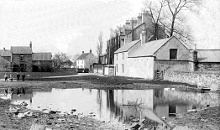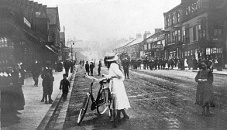
Tudhoe & Spennymoor Local History Society



We won't be having a talk in June as there is an outing for members which has to be pre-booked before the 10th June.
Next Talk - Monday 28th July 2025 at 7.30pm - Wood View in Shincliffe - a Terrace Through Time by Garry Stout.
Held at St. David's Church Hall, Tudhoe Lane, Tudhoe, DL16 6LL.
Members free, Visitors £4.
Please note tea and biscuits will be served before the start of the meeting at a charge of £1.
Hosted by DurhamWeb.
June 1875 - Petitions, Advertisements, Court, Industry, Workhouse/Chapel.
The Boer War started in 1899, click to see updates from June 1900: Capture of Pretoria, Rev J M Peart, Private George Elsdon, Celebrations.
To see all events and letters from soldiers at the front go to Boer War.
The Society was formed in 1988 and its aims are to organise an annual programme of talks and outings and attend events promoting local history. For more details go to TSLHS History.
Click to view our Time Line. - 2024 is Spennymoor Town Council's 50th anniversary year so we have produced a Time Line covering those years. This started as part of a much longer time line originally compiled by Eric Coombes.
Click to view our Photo Archive - over 1,000 photographs of Tudhoe, Spennymoor and surrounding areas. These images are protected by copyright licensing regulations and are for personal use only, they cannot be copied, published or distributed.
Click to view our Requests for Information If you can help please e-mail tslhs@btinternet.com

 Behind the Lines: a First World War Nurse and the fight for Survival. Our film about medical services on the Western Front and the contribution of Spennymoor people to them is free to view on YouTube under a creative commons licence.
Behind the Lines: a First World War Nurse and the fight for Survival. Our film about medical services on the Western Front and the contribution of Spennymoor people to them is free to view on YouTube under a creative commons licence.
To view the film, see more information about Kate Maxey, photos of the Film Premiere, details of DVDs, Education packs and film presentations go to Behind the Lines.
Situated on the south side of the Wear Valley, midway between the ancient settlements of Bishop Auckland and Durham, Spennymoor only came into existence during the mid 19C. Previously, eight villages, all now satellites of this small market town, surrounded the open common known as the Spenny Moor. Most of these, including Tudhoe, already existed when the Boldon Book, the North East’s equivalent to the earlier Domesday Book, was compiled in 1183.
650 years later, exploitation of County Durham's mineral wealth, principally its huge reserves of coal, began to help satisfy the needs of Britain's industrial revolution. This resulted in the creation or expansion of many towns and villages in the eastern half of the County. Spennymoor is one such example of this change.
By 1840, coal pits were being sunk around the Moor, soon accompanied by houses to accommodate the ever growing number of miners. An iron and steel works quickly followed, established here to exploit the large quantities of coal now being produced around the expanding settlement. While never completely absorbing any of the villages, it is now physically linked to Tudhoe.
By the turn of the 20th Century coal and steel had long given way to service and manufacturing industries while the expanded town now also functioned more widely as a dormitory to the large coastal conurbations set around the mouths of the Tyne, Wear and Tees. For more details go to History.